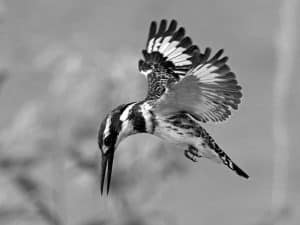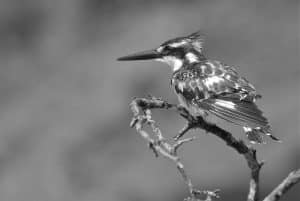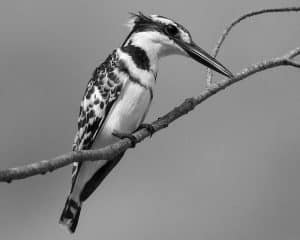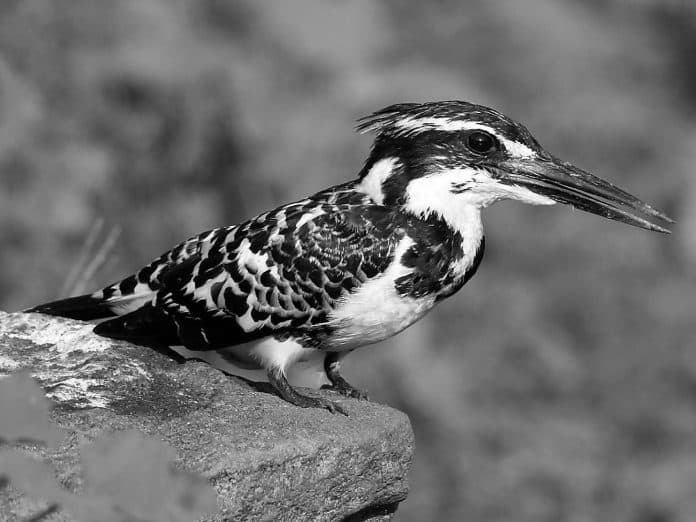Introduction to the Pied Kingfisher
The pied kingfisher (Ceryle rudis) is a striking bird species found in Tanzania, known for its distinctive black and white plumage and impressive hunting skills. This medium-sized bird belongs to the kingfisher family and is easily recognizable by its unique appearance and hovering hunting technique. The pied kingfisher in Tanzania is a common sight near water bodies, including rivers, lakes, and coastal areas, where it hunts for fish and other aquatic prey. With its characteristic black and white coloration and remarkable aerial acrobatics, the pied kingfisher is a fascinating bird that captivates the attention of birdwatchers and nature enthusiasts in Tanzania.

The pied kingfisher is widely distributed across sub-Saharan Africa, including Tanzania, where it can be found in various habitats such as freshwater lakes, rivers, and estuaries. This adaptable bird is known for its distinctive hunting behavior, which involves hovering over the water before diving to catch its prey. The pied kingfisher’s remarkable fishing skills and striking appearance make it a sought-after subject for birdwatchers and wildlife photographers in Tanzania. As a key player in the ecosystem, the pied kingfisher also plays a crucial role in maintaining the balance of aquatic food chains and ecosystems in Tanzania.
Habitat and Behavior of the Pied Kingfisher in Tanzania
In Tanzania, the pied kingfisher is commonly found near water bodies, including the shores of lakes, rivers, and coastal areas. This species prefers open habitats with clear, still waters, where it can easily spot and catch fish, its primary source of food. The pied kingfisher’s hunting strategy is a spectacle to behold, as it hovers over the water with rapid wingbeats, using its keen eyesight to locate potential prey below the surface. Once it has pinpointed a target, the pied kingfisher plunges into the water with remarkable precision, emerging with its catch in its beak.
During the breeding season, pied kingfishers excavate nesting burrows in earthen banks along water bodies, where they raise their young. These nesting sites provide protection for the vulnerable chicks and contribute to the overall population of pied kingfishers in Tanzania. The pied kingfisher’s behavior and habitat preferences make it a prominent feature of Tanzania’s aquatic landscapes, adding to the richness and diversity of the country’s avian fauna.
The Significance of the Pied Kingfisher in Tanzanian Culture and Ecology
The pied kingfisher holds cultural and ecological significance in Tanzania, where it is admired for its grace, agility, and role in maintaining the health of aquatic ecosystems. In Tanzanian folklore and traditions, the pied kingfisher is often associated with themes of abundance, prosperity, and the natural balance of the environment. Its presence near water bodies is seen as a symbol of the interconnectedness of ecosystems and the vitality of freshwater resources.
Ecologically, the pied kingfisher contributes to the control of fish populations in Tanzanian waterways, playing a vital role in the regulation of aquatic food webs. By preying on small fish and aquatic invertebrates, the pied kingfisher helps to maintain the balance of species and prevent overpopulation of certain fish species in Tanzania’s freshwater habitats. As a result, the pied kingfisher’s presence has a cascading effect on the overall health and biodiversity of Tanzania’s aquatic ecosystems.
Best Places to Spot Pied Kingfishers in Tanzania
Tanzania offers a variety of prime locations for observing pied kingfishers in their natural habitat. The country’s extensive network of rivers, lakes, and wetlands provides ample opportunities for birdwatchers and nature enthusiasts to catch a glimpse of these captivating birds. Lake Manyara, a picturesque alkaline lake in northern Tanzania, is known for its abundant birdlife, including pied kingfishers that can be spotted along the lake’s shoreline and in the surrounding woodlands.
Another renowned destination for pied kingfisher sightings is the Rufiji River in the Selous Game Reserve, where these birds can be observed darting over the water’s surface in search of prey. The Rufiji River’s diverse aquatic environments support a rich array of wildlife, making it an ideal location for experiencing the natural behaviors of pied kingfishers in their native habitat. Additionally, the coastal regions of Tanzania, such as the shores of the Indian Ocean, provide opportunities to witness pied kingfishers in action as they hunt for fish along the water’s edge.
Conservation Efforts for Pied Kingfishers in Tanzania

Despite being a common sight in Tanzanian waterways, pied kingfishers face various threats that impact their populations and habitats. Habitat degradation, pollution, and disturbances near nesting sites are among the challenges that affect these birds in Tanzania. To address these issues and safeguard the pied kingfisher’s future, conservation efforts are essential.
Conservation organizations and local authorities in Tanzania have implemented measures to protect the habitats of pied kingfishers and raise awareness about the importance of preserving these birds and their surrounding ecosystems. By promoting sustainable practices, such as responsible tourism and habitat restoration, these initiatives aim to mitigate the threats facing pied kingfishers and ensure the long-term viability of their populations in Tanzania. Engaging local communities in conservation education and monitoring the pied kingfisher’s populations are crucial components of these efforts, contributing to the overall conservation of this iconic bird species.
Photographing Pied Kingfishers in Tanzania
For wildlife photographers visiting Tanzania, capturing the beauty and behavior of pied kingfishers presents an exciting opportunity. The striking contrast of the bird’s black and white plumage, combined with its dynamic hunting maneuvers, makes it an appealing subject for photography. To enhance the chances of photographing pied kingfishers in their natural environment, it is important to choose strategic locations and be mindful of the birds’ behavior and movements.
Patience and observation are key when photographing pied kingfishers, as their hunting activities can unfold unpredictably. By positioning oneself near favored perches or hunting grounds, photographers can increase their chances of witnessing the pied kingfisher’s aerial displays and fishing techniques. Utilizing telephoto lenses and camera equipment suited for capturing fast-paced action can help photographers achieve stunning images of pied kingfishers in flight and during their hunting dives. Respect for the birds and their surroundings is paramount, ensuring that photography activities do not disrupt the pied kingfisher’s natural behaviors or nesting sites.
The Unique Features of the Pied Kingfisher
The pied kingfisher’s distinct appearance and fascinating adaptations set it apart from other bird species in Tanzania. Its black and white plumage, coupled with a bold black band across its chest, makes the pied kingfisher instantly recognizable, even from a distance. This coloration serves as a form of camouflage, allowing the bird to blend in with its surroundings and approach prey without alerting potential targets.
In addition to its striking appearance, the pied kingfisher possesses specialized anatomical features that enable it to excel in its aquatic hunting pursuits. Its long, pointed bill is well-suited for capturing fish, while its strong, agile wings facilitate precise flight and hovering maneuvers. The pied kingfisher’s keen eyesight and depth perception further enhance its ability to detect and intercept prey beneath the water’s surface, making it a formidable hunter in Tanzania’s aquatic environments.
Tips for Birdwatching and Identifying Pied Kingfishers in Tanzania
When engaging in birdwatching activities in Tanzania, it is helpful to familiarize oneself with the key characteristics of pied kingfishers to aid in their identification. The bird’s black and white coloration, prominent crest, and distinctive flight patterns are valuable traits for recognizing pied kingfishers in the field. Observing their behavior, such as their hovering flights and sudden dives into the water, can provide further clues to their presence.
To enhance the birdwatching experience, binoculars and field guides specific to Tanzanian avifauna can assist in identifying and appreciating the diverse bird species, including pied kingfishers. Exploring diverse habitats, such as freshwater lakes, riverbanks, and coastal marshes, increases the likelihood of encountering pied kingfishers and observing their natural behaviors. As with any form of wildlife observation, maintaining a respectful distance and minimizing disturbances to the birds and their surroundings are essential considerations for ethical birdwatching practices in Tanzania.
Conclusion and the Future of Pied Kingfishers in Tanzania

In conclusion, the pied kingfisher holds a special place in the avian tapestry of Tanzania, enchanting observers with its striking appearance and remarkable hunting prowess. As a key player in the country’s aquatic ecosystems, the pied kingfisher contributes to the ecological balance and cultural symbolism of Tanzania’s natural landscapes. By understanding the habitat, behavior, and conservation needs of pied kingfishers, individuals can contribute to the ongoing efforts to protect and appreciate these captivating birds in Tanzania.
Looking ahead, the future of pied kingfishers in Tanzania relies on the collective commitment to conservation, sustainable management of natural resources, and the preservation of their habitats. Through responsible ecotourism, environmental education, and collaborative conservation initiatives, Tanzania can continue to be a haven for pied kingfishers and a destination where their beauty and significance are celebrated. By fostering a harmonious coexistence between humans and wildlife, Tanzania can ensure that pied kingfishers thrive in the country’s skies and waterways for generations to come.


































